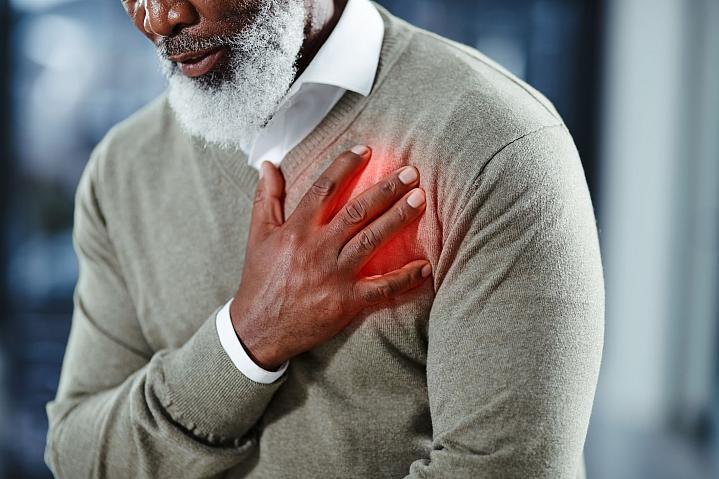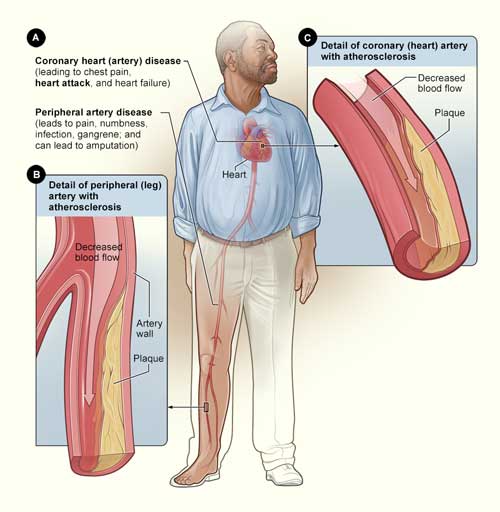How Does Smoking Affect the Heart and Blood Vessels?– Smoking and Your Heart
Cigarette smoking causes about 1 in every 5 deaths in the United States each year. It’s the main preventable cause of death and illness in the United States.
Smoking harms nearly every organ in the body, including the heart, blood vessels, lungs, eyes, mouth, reproductive organs, bones, bladder, and digestive organs. This article focuses on how smoking affects the heart and blood vessels.
Other Health Topics articles, such as COPD (chronic obstructive pulmonary disease), Bronchitis, and Cough, discuss how smoking affects the lungs.
Overview
Smoking and Your Heart and Blood Vessels
The chemicals in tobacco smoke harm your blood cells. They also can damage the function of your heart and the structure and function of your blood vessels. This damage increases your risk of atherosclerosis.
Atherosclerosis is a disease in which a waxy substance called plaque builds up in the arteries. Over time, plaque hardens and narrows your arteries. This limits the flow of oxygen-rich blood to your organs and other parts of your body.
Ischemic heart disease occurs if plaque builds up in the arteries that supply blood to the heart, called coronary arteries. Over time, heart disease can lead to chest pain, heart attack, heart failure, arrhythmias, or even death.
Smoking is a major risk factor for heart disease. When combined with other risk factors—such as unhealthy blood cholesterol levels, high blood pressure, and overweight or obesity—smoking further raises the risk of heart disease.
Smoking also is a major risk factor for peripheral artery disease (P.A.D.). P.A.D. is a condition in which plaque builds up in the arteries that carry blood to the head, organs, and limbs. People who have P.A.D. are at increased risk for heart disease, heart attack, and stroke.
Smoking and Atherosclerosis
The image shows how smoking can affect arteries in the heart and legs. Figure A shows the location of coronary heart disease and peripheral artery disease. Figure B shows a detailed view of a leg artery with atherosclerosis—plaque buildup that partially blocks blood flow. Figure C shows a detailed view of a coronary artery with atherosclerosis.
Any amount of smoking, even light smoking or occasional smoking, damages the heart and blood vessels. For some people, such as women who use birth control pills and people who have diabetes, smoking poses an even greater risk to the heart and blood vessels.
Secondhand smoke also can harm the heart and blood vessels. Secondhand smoke is the smoke that comes from the burning end of a cigarette, cigar, or pipe. Secondhand smoke also refers to smoke that’s breathed out by a person who is smoking.
Secondhand smoke contains many of the same harmful chemicals that people inhale when they smoke. Secondhand smoke can damage the hearts and blood vessels of people who don’t smoke in the same way that active smoking harms people who do smoke. Secondhand smoke greatly increases adults’ risk of heart attack and death.
Secondhand smoke also raises children and teens’ risk of future ischemic heart disease because it:
- Lowers HDL cholesterol (sometimes called “good” cholesterol)
- Raises blood pressure
- Damages heart tissues
The risks of secondhand smoke are especially high for premature babies who have respiratory distress syndrome (RDS) and children who have conditions such as asthma.
Researchers know less about how cigar and pipe smoke affects the heart and blood vessels than they do about cigarette smoke.
However, the smoke from cigars and pipes contains the same harmful chemicals as the smoke from cigarettes. Also, studies have shown that people who smoke cigars are at increased risk for heart disease.
Benefits of Quitting Smoking and Avoiding Secondhand Smoke
One of the best ways to reduce your risk of heart disease is to avoid tobacco smoke. Don’t ever start smoking. If you already smoke, quit. No matter how much or how long you’ve smoked, quitting will benefit you.
Also, try to avoid secondhand smoke. Don’t go to places where smoking is allowed. Ask friends and family members who smoke not to do it in the house and car.
Quitting smoking will reduce your risk of developing and dying from heart disease. Over time, quitting also will lower your risk of atherosclerosis and blood clots.
If you smoke and already have heart disease, quitting smoking will reduce your risk of sudden cardiac death, a second heart attack, and death from other chronic diseases.
Researchers have studied communities that have banned smoking at worksites and in public places. The number of heart attacks in these communities dropped quite a bit. Researchers think these results are due to a decrease in active smoking and reduced exposure to secondhand smoke.
Outlook
Smoking or exposure to secondhand smoke damages the heart and blood vessels in many ways. Smoking also is a major risk factor for developing heart disease or dying from it.
Quitting smoking and avoiding secondhand smoke can help reverse heart and blood vessel damage and reduce heart disease risk.
Quitting smoking is possible, but it can be hard. Millions of people have quit smoking successfully and remained nonsmokers. A variety of strategies, programs, and medicines are available to help you quit smoking.
Not smoking is an important part of a heart-healthy lifestyle. A heart-healthy lifestyle also includes heart-healthy eating, aiming for a healthy weight, managing stress, and physical activity.




